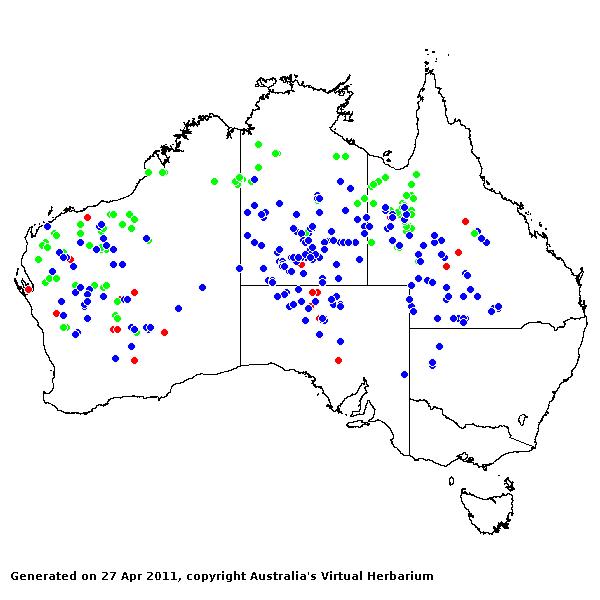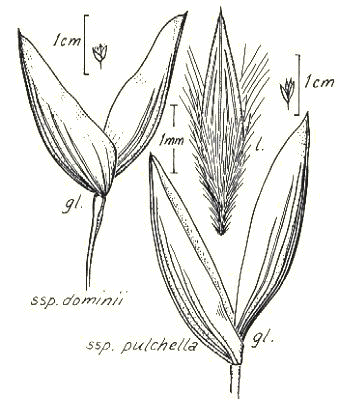Eriachne pulchella Domin. Repert.
Spec. Nov. Regni Veg 9: 552 (1911).
Classification. (GPWG 2001) : Subfamily
Micrairoideae. Eriachneae.
Type of Basionym or
Protologue Information: Australia, Between Ashburton & De Grey R.: Clement (K syn); Australia, Western
Australia, Whim Creek: Mitchell comm. Winn (K syn).
Recent synonyms:
E. isingiana.
Key references
(books and floras): [1952] C.A.Gardner, Flora of Western Australia 1
Gramineae (51), [1981] M.Lazarides in J.Jessop (ed)., Flora of
Central Australia (442 & as E. isingiana), [2002] D.Sharp &
B.K.Simon, AusGrass, Grasses of Australia, [2006] J.Jessop,
G.R.M.Dashorst, F.M.James, Grasses of South Australia (424), [2008]
S.W.L.Jacobs, R.D.B.Walley & D.J.B.Wheeler, Grasses of New South Wales
(261).
Illustrations:
[2006] J.Jessop, G.R.M.Dashorst, F.M.James, Grasses of South Australia (424, fig. 355), [2008] S.W.L.Jacobs,
R.D.B.Whalley & D.J.B.Wheeler, Grasses of New South Wales, 4th edn (262).
Habit. Annual
or ephemeral. Culms stature slender to delicate, 2–30 cm tall, 1–2 -noded.
Mid-culm nodes glabrous. Lateral branches simple or sparsely branched or
branched or fastigiate. Leaves mostly basal. Ligule a fringe of hairs.
Leaf-blades 20 cm long, 1–3.5 mm wide. Leaf-blade surface scabrous, indumented.
Inflorescence.
Inflorescence compound, a panicle. Panicle linear, 1–5 cm long, 0.5–1 cm wide.
Spikelets.
Spikelets pedicelled. Fertile spikelets 2-flowered, both fertile, comprising 2
fertile floret(s), without rachilla extension, ovate, laterally compressed, 2–5
mm long.
Glumes.
Glumes similar, thinner than fertile lemma. Lower glume ovate, scarious,
without keels, 5–7 -nerved. Lower glume surface glabrous. Lower glume apex
muticous or mucronate. Upper glume ovate, 2–5 mm long, scarious, without keels,
5–7 -nerved. Upper glume surface smooth, glabrous. Upper glume apex muticous or
mucronate.
Florets.
Fertile lemma 3–4.8 mm long, without keel, 5–7 -nerved. Lemma surface
indumented. Lemma apex muticous or mucronate. Palea apex entire or dentate.
Grain 1.3–1.5 mm long.
Continental
Distribution: Australasia.
Australian
Distribution: Western Australia, Northern Territory, South Australia,
Queensland, New South Wales.
Western Australia:
Canning, Carnegie, Fortescue, Carnarvon, Austin. Northern Territory:
Victoria River, Barkly Tableland, Central Australia North, Central Australia
South. South Australia: North-western, Lake Eyre. Queensland:
Burke, Gregory North, Maranoa, Warrego, Gregory South. New South Wales:
North Far Western Plains.
Notes. Endemic.
Subsp. pulchella
Northern S.A., NW N.S.W., and extending to
20ºS in W Qld, N.T. and W.A. A common plant of shallow and skeletal soils on
hillslopes, outcrops and terraces over laterite, sandstone or granite, often in
barren or scalded, stony or gravelly or pebbly sites; also recorded from plains
with deeper sandy or clayey loams, seepage slopes, seasonal creek beds, and
near salt lakes. In overlapping areas of distribution, the two subspecies are
sometimes ecologically sympatric. Over its distribution range, flowers and
fruits throughout the year.
subsp. dominii
W Qld, N.T. and W.A. between 16ºS and 24ºS.
Common in skeletal often pebbly or stony soils on hillslopes, outcrops and
ridges of sandstone, quartzite and laterite; recorded also from sandplains,
reddish-brown loams and from disturbed ground. Flowers and fruits chiefly
Apr.-July (mid-autumn to mid-winter), also Nov. (late-spring).
Inflorescence densely
spicate, up to 3.5 cm long when mature E. pulchella subsp. pulchella
Inflorescence
loosely spicate, more than 3.5 cm long when mature E. pulchella subsp. dominii



